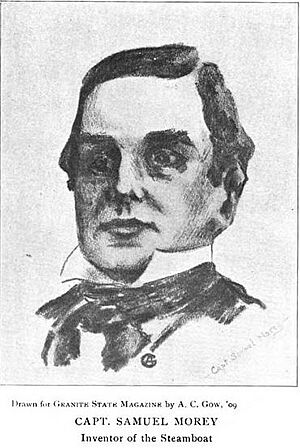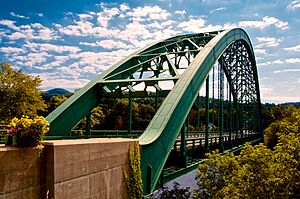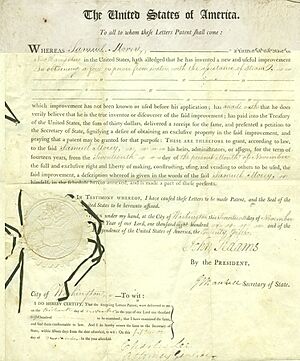Samuel Morey facts for kids
Quick facts for kids
Samuel Morey
|
|
|---|---|

An illustration of Samuel Morey from 1909.
|
|
| Born | October 23, 1762 |
| Died | April 17, 1843 (aged 80) Fairlee, Vermont, U.S.
|
| Resting place | West Cemetery, Orford, New Hampshire |
| Occupation | Businessman Inventor |
| Engineering career | |
| Significant advance | Heated-surface carburetor Ethanol internal combustion engine Steamboat design and construction |
Samuel Morey (born October 23, 1762 – died April 17, 1843) was an American inventor. He created early internal combustion engines and was a leader in developing steamboats. Morey received a total of 20 patents for his inventions.
Contents
Early Life of Samuel Morey
Samuel Morey was born in Hebron, Connecticut. He was the second of seven children. His father, Israel Morey, was a soldier who rose to the rank of general. In 1768, when Samuel was young, his family moved to Orford, New Hampshire.
Samuel Morey later ran a successful lumber business. He worked in both Orford and Fairlee, Vermont. He passed away in 1843 and was buried in Orford. Lake Morey in Vermont is named after him to honor his work.
Steamboat Inventions
Samuel Morey received his first patent in 1793 for a steam-powered cooking spit. But he had much bigger ideas! In the 1780s, he realized that steam could be a powerful source of energy. He likely saw the potential for steamboats while working on his father's ferry. He also designed locks along the Connecticut River.
In the early 1790s, Morey put a paddle wheel and a steam engine onto a small boat. He successfully powered it up and down the Connecticut River. People say he did this on a Sunday morning. He wanted to avoid being laughed at if his experiment failed.
The Important Paddle Wheel
The most important part of Morey's early steamboat was the paddle wheel. This idea had been around for a long time. Others had tried using it with steam engines before. For example, Jonathan Hulls in England used a rear paddle wheel in 1737. But his engine was not very good at turning the wheel.
In America, John Fitch tried side-mounted paddle wheels. But he later used and patented oars instead in 1791. Samuel Morey's work might have been the first successful use of a steam-powered paddle wheel. This was the best way to move boats until the propeller was improved.
A road sign in Vermont celebrates Morey's achievement. It says he "successfully operated a steamboat on the Conn. River in 1793."
Developing His Steamboat
Morey's first boat was just a test. So, he built another one in New York. He spent the next few summers improving his boat. He traveled to New York and Hartford, Connecticut, to show it off. In 1797, he built a boat with two side-mounted paddle wheels. He felt this boat was ready for business.
Morey looked for people to invest money in his invention. But for unknown reasons, his plans fell apart. This was likely the end of Morey's direct work with steamboats. However, he continued to get patents for other steam engine improvements. He received patents in 1795, 1799, 1800, and 1803.
Steamboat Controversy
Even though Morey built a working steamboat, Robert Fulton and his investor, Chancellor Robert Livingston, got credit for the first successful steamboat line. Morey believed they used some of his ideas.
Morey said that Livingston rode in his boat in New York. Livingston was impressed. He offered Morey money if he could make the boat go 8 miles per hour. He also offered $7,000 for the rights to use Morey's work in New York. Morey turned down the offer. He kept working to reach Livingston's speed goal. Morey also talked with Fulton and Livingston. Livingston even visited Morey in Orford.
Later, Morey was reportedly on Fulton's boat. He told Fulton he was unhappy that his ideas had helped Fulton so much, but not him.
Morey's Revolving Steam Engine
In 1815, Morey patented a "revolving" steam engine. This engine was described in a science journal in 1819. It was generally well-liked. Instead of a fixed cylinder, Morey's cylinder could pivot as it moved. This helped turn a crank. The pivoting cylinder also acted as a valve. It controlled the steam flow.
This engine was light, fast, strong, and cheap to build. It was used in tugboats, a glass factory, and a sawmill. One tugboat even sailed to South Carolina, and its owner was happy with it. Morey received one more steam patent in 1817. But by then, he was more interested in experiments with flammable vapors.
Experiments with Vapors and Combustion
Samuel Morey was very curious. In 1834, he wrote that for over 20 years, he had been experimenting daily. He mixed water vapor with turpentine vapor and air. This led to many discoveries. These included the liquid-fueled internal combustion engine. He also found a way to carbonate water and noticed strange bubbles from melted resin.
Morey observed how flames burned differently near knots in wood or wet wood. He experimented with almost anything he could find. This included tar, rosin, turpentine, alcohol, oils, fats, and even seeds.
His experiments were described in science journals. He didn't always have a clear theory first. But his discoveries were often very valuable. In 1834, he suggested a theory of combustion where electricity was the main force.
Producing Heat and Light
Morey's first practical use of his experiments was to heat water for his revolving engine. He noticed that passing steam over burning coal or tar made the flames brighter and smokeless. He thought the steam was breaking down.
Morey was correct! He produced what is now called town gas. The oxygen from the water combined with carbon from the fuel. This formed carbon monoxide and hydrogen gas. Both then burned to create water and carbon dioxide. Morey's devices, like his 1818 American Water Burner, used this gas right away. This produced more light and burned fuel more efficiently.
Internal Combustion Engine Work
During his experiments, Morey found that turpentine vapor mixed with air was explosive. He saw its potential and developed an engine. He wrote about it in 1824 and patented it in 1826.
How Morey's Engine Worked
Morey's engine had many features similar to modern engines. It had two cylinders, a carburetor, and a system of valves and cams. But unlike modern engines, the explosion didn't directly provide power. Instead, the explosion pushed air out of the cylinder through a one-way valve.
The cylinder was cooled by a water jacket. Water was also sprayed into the burning chamber after it fired. The cooling gases created a vacuum. Then, air pressure pushed the piston. Morey did try direct action, but his method was more complex.
Demonstrations and Challenges
Morey showed his engine in New York and Philadelphia. People saw it powering a boat and a wagon in Philadelphia. He even demonstrated a car on the street. But he fell off after starting the engine. The vehicle then drove across Market Street into a ditch! This was the second car ride in the world and the first in the United States.
Despite these mostly successful demonstrations, Morey couldn't find anyone to buy his invention. He became frustrated. In 1829, a letter mentioned Morey's trip to Baltimore. He was determined to make one last effort to sell his vapor engine patent. If he failed, he would give up and return home. He didn't find a buyer. Since he was in his late 60s, he decided to stop traveling and retire.
Morey's Unique Contributions
Morey's engine was very advanced for its time. It was the first documented internal combustion engine in the United States. His use of liquid fuel and a heated surface carburetor was a world first. He also used a wire mesh to stop the combustion from reaching the carburetor. This feature was later reinvented and patented again in 1872. This happened because Morey's original patent was lost in the 1836 U.S. Patent Office fire.
Morey's vapor engine was his most forward-thinking invention. In 1824, he wrote that this discovery could greatly change travel. He believed transportation on roads or railroads could be cheaper and faster. He also thought horses might not be needed for personal travel. He even suggested using the engine to power balloons!
Today, people often focus on Morey's engine. Charles Duryea, who made the first gasoline engine in America around 1890, helped popularize Morey's work. He funded two working copies of Morey's engine. One is at the Smithsonian museum. More recently, American comedian Jay Leno, a car collector, has also brought attention to Morey's work.
Honors
- [Samuel Morey Elementary School]
Articles by Samuel Morey
- "On preserving Indian Corn from frost", Memoirs of the Philadelphia Society for Promoting Agriculture, Volume 4
- "On a new revolving steam engine", Edinburgh Philosophical Journal 1 (1819): pp. 348–352 (also in American Journal of Science 1818)
- "On the Revolving Steam Engine" of SAMUEL MOREY. J. L. SULLIVAN. American Journal of Science and Arts, 4, 57, (1819).
- "On the Revolving Steam Engine". ISAAC DOOLITTLE. American Journal of Science and Arts, 2, 101, (1820).
- "On A New Means of Producing Heat and Light". SULLIVAN. American Journal Of Science and Arts, 1, 91 (1819).
- "On heat and light", American Journal of Science and Arts 2 (1820): pp. 118–132.
- "On Heat and Light". MOREY. American Journal of Science and Arts, 2, 118, 122 (1820).
- "Bubbles blown in Melted Rosin." MOREY. American Journal of Science and Arts, 2, 179 (1820).
- "On artificial mineral waters, with some remarks on artificial light", American Journal of Science and Arts 3 (1821): pp. 94–102.
- "On Fetid Crystallized Limestone". MOREY. American Journal of Science and Arts, 3, 324 (1821).
- "Remarks on the patent Water-Burner". American Journal of Science and Arts 7 (1824): pp. 141–145.
- "An account of a new explosive engine, generating a power that may be substituted for that of the steam engine". American Journal of Science and Arts 11 (1826): pp. 104–110.
- "An Account of a New Explosive Engine", generating a Power that may be Substituted for that of the Steam Engine. MOREY. American Journal of Science and Arts, r I, 104 ( 1826). Journal Of the Franklin Institute, 2, 115 (1826).
- "Observations on combustion and the powers concerned in that process", American Journal of Science and Arts 25 (1834): pp. 146–151.
Samuel Morey's Patents
Samuel Morey held many patents. Some of his notable ones include:
- X51 Turning A Spit
- X246 New And Invented Water Engine
- X306 Force From Water With Assist Of Steam
- X2,339 Steam Engine (Granted July 14, 1815)
- X2,752 Tide And Current Water Wheel For Driving Mills Or Machinery With Or Without A Dam
- X2,880 Method Of Burning Water Called The American Water Burner
- X3,060 Shooting With Steam And Gas
- X4,378 Gas Or Vapor Engine
- X7,826 Decomposing And Recomposing Water In Combo With Spirits Of Turpentine
- 95X Improvement in Applying Steam
- 107X Raising Water by Wind
- 244X Obtaining force from water by steam
- 462X Steam Engine (with Rufus Graces and Richard Giles)
- 1740X Power from difference between rarefied and unrarefied air (Mode of obtaining power between the difference of a column of rarified and unrarified air.)
- 1867X Fireplace and chimney for saving fuel
- 2753X Boiler for steam engines
- 3042X Treble pipe steam boiler
- 3043X Improvement on the American water burner
See Also
- 1877 U. S. Patent Office fire
- 1836 U.S. Patent Office fire
- History of the internal combustion engine
- Horst O. Hardenberg, "The Middle Ages of the I.C. Engine" (Warrendale, 1999) pages 115-132.
- Samuel Morey papers, 1793 - 1860, Dartmouth Library



